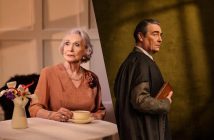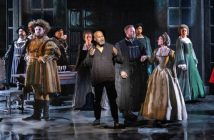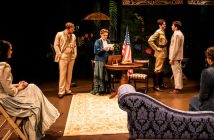Shakespeare made it easy. If the play ended with a marriage, it was a comedy. If it ended without, it was a tragedy. Reasons to be Happy claims to be a romantic comedy, but even with its jokes and awkward moments, with such an unhappy ending, can it really claim to be anything more than a tragedy?
The play is the second part in a triptych of plays by writer, Neil Labute. It follows Reasons to be Pretty, the first play to focus on four modern day Americans: Greg, Carly, Steph and Kent. Labute is not known for his romantic comedies; much of his previous work has been black comedy and unsettling drama, with a consistent aversion to happy endings. This play is much of the same.

The story’s main theme is, of course, relationships. It’s centred on one character, Greg, an irritating and oddly attractive man, played brilliantly by Tom Burke, who is dating a pretty security officer called Carly (Robyn Addison). His ex-girlfriend, Steph (Lauren O’Neil), meanwhile proclaims to be madly in love with him, so he’s faced with a decision – which woman does he choose? The only problem is, Greg is incapable of making decisions and tends to just ‘go with the flow’ and as an audience, its hard to care either way what decision he finally makes or has made for him.
Steph has little character development, but it’s clear that she’s not the sharpest tool in the box (she thinks Turkey is located in that ‘jumbled’ bit of the map) and has little handle on her infantile outbursts of rage. Carly is written with even less characteristics, other than the fact that she’s attractive and Greg considers her a ‘sweet person’. The comedic aspects of the play come from the women’s constant frustration at Greg’s incompetence.

It’s disappointing that Michael Attenborough’s direction is fairly static, with little movement around the set, for the focus is more on dialogue than either action or expression, as Labute openly admits: ‘I prefer to write what people say rather than write down what they do – dialogue is action to me.’ But whilst we know that Labute didn’t concentrate on giving much action guidance here, one can’t help but feel that the comedy has suffered from a severe lack of physical direction.
Soutra Gilmore’s set is the most creative aspect of the production. As the play begins, the characters stand outside a large rusty shipping container, with wafts of smoke unfurling around its edges, and as the story develops, the box ingeniously unfolds on either side, turning to reveal each room inside. The costumes, designed by Chris Cahill, also work well with the story and set, not shouting for attention, but fitting in naturally with the environment. Greg wears a typical academic outfit – a sort of brown, run down suit and the other characters all wear typical modern day American clothing. The soft, central lighting by Oliver Fenwick works nicely, whilst the intimate feel of Hampstead Theatre enhances the atmosphere of the production.
Labute’s play does have its comedic moments, but by the time you get to the end, you don’t feel the satisfaction that the characters have truly changed or really learned anything about themselves through their mistakes. The story is left hanging on a ‘maybe one day’ and one character sobbing uncontrollably in a quiet room. It’s worth considering that if all the questions were answered in Labute’s second play, we might have no desire to find out what happens to the characters in the next. So maybe happiness will finally be found in ‘Reasons to be Pretty Happy‘, and then we can call this heartbreak of a play, a comedy.
Reasons to be Happy at Hampstead Theatre until 23rd April 2016. Running time 2 hours 10 minutes including an interval. For more information and tickets visit the website.




